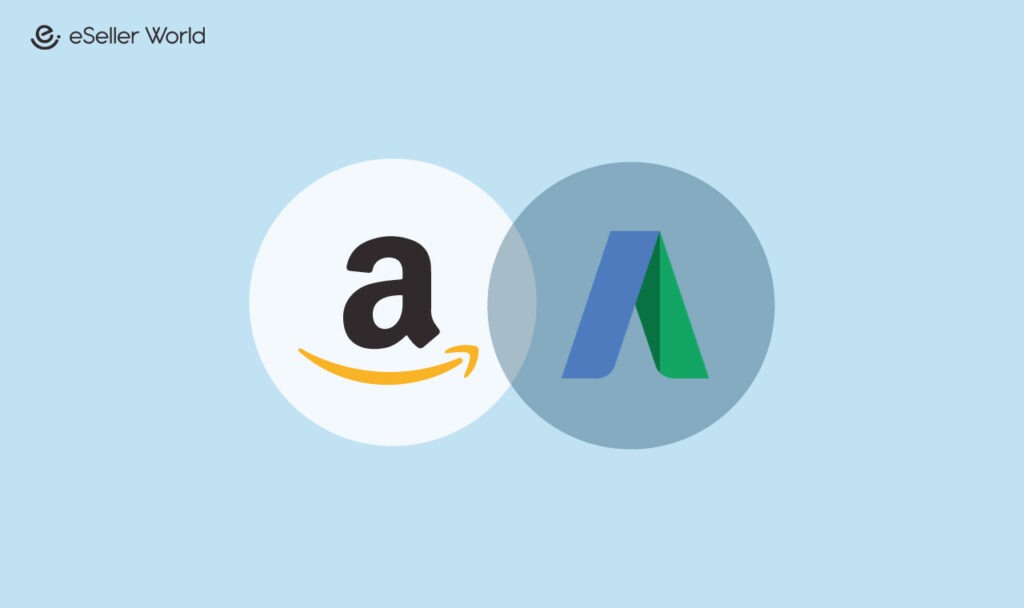Google Ads vs. Amazon Ads: Finding the Right Balance for Maximum Impact
In the ever-evolving landscape of digital marketing, the debate over where to allocate advertising budgets often comes down to Google Ads versus Amazon Ads. Both platforms offer unique advantages and cater to distinct user behaviors, making the decision of where to invest a crucial one for businesses aiming to maximize their impact.

Amazon Advertising vs. Google Advertising: Finding the Right Balance for Maximum Performance
Understanding the Platforms
Google Ads:
Google Ads, formerly known as Google AdWords, reigns as the dominant player in the realm of online advertising. It operates on a pay-per-click (PPC) model and displays ads across the Google Network, including the search engine results pages (SERPs), partner websites, YouTube, and more. Its strength lies in intent-based targeting, leveraging keywords and user search queries to connect advertisers with audiences actively seeking information or solutions.
Detailed Insights into Google Ads:
Ad Formats and Placement
- Search Network Ads: Text-based ads displayed on Google search engine results pages (SERPs) triggered by relevant keywords or phrases. They appear above or below the organic search results.
- Display Network Ads: Visual ads (image, video, responsive) that appear across a vast network of websites, apps, and videos partnered with Google.
- Shopping Ads: Product-based ads showcasing images, prices, and descriptions for specific products, prominently displayed in Google Shopping results.
- Video Ads: Advertisements shown on YouTube before, during, or after videos, including skippable and non-skippable formats.
- App Promotion Ads: Designed to increase app downloads or engagement, appearing on Google Search, Play Store, YouTube, and other partner sites.
Targeting Options:
- Keywords: Allows targeting based on specific search terms or phrases relevant to the product or service being advertised.
- Demographics: Targeting based on age, gender, parental status, household income, and more.
- Interests and Behaviors: Targeting users based on their interests, online behaviors, past interactions, and browsing history.
- Remarketing: Reaching users who have previously interacted with your website or app.
- Placement Targeting: Choosing specific websites, apps, or placements within the Google Display Network to display ads.
- Custom Audiences: Creating audiences based on customer data, such as email lists or CRM data, for more targeted advertising.
Bidding Strategies:
- CPC (Cost Per Click): Pay when someone clicks on your ad.
- CPM (Cost Per Thousand Impressions): Pay per thousand impressions/views of your ad.
- CPA (Cost Per Acquisition): Pay when a specific action (like a purchase or form submission) is completed.
- ROAS (Return on Ad Spend): Optimizing bids to maximize revenue based on the amount spent on ads.
Ad Extensions and Features:
- Sitelink Extensions: Additional links within the ad directing users to specific pages on the website.
- Callout Extensions: Highlighting unique selling points or offers within the ad.
- Structured Snippets: Displaying specific information about products or services in the ad.
- Location Extensions: Showing the physical location of a business alongside the ad.
- Ad Customizers: Dynamically changing ad content based on parameters like location, device, or audience.
Measurement and Analytics:
- Google Analytics Integration: Connecting Google Ads with Google Analytics to track user behavior, conversions, and other valuable metrics.
- Conversion Tracking: Monitoring specific actions users take after clicking on an ad, such as form submissions, purchases, or sign-ups.
- Attribution Models: Understanding how different touchpoints contribute to conversions, allowing for informed optimization of ad campaigns.
Optimization and Testing:
- A/B Testing: Experimenting with different ad elements (copy, images, landing pages) to determine which performs best.
- Ad Schedule and Bid Adjustments: Optimizing ad delivery based on the time of day, device, or location to reach the most relevant audience.
- Quality Score Improvement: Enhancing ad relevance, landing page experience, and expected click-through rates to improve ad rankings and lower costs

Amazon Ads:
Amazon Ads, on the other hand, primarily functions within the Amazon ecosystem. It offers various ad formats, including sponsored products, sponsored brands, and sponsored display ads, strategically positioning promotions within the e-commerce giant’s marketplace. Amazon Ads leverages the platform’s immense product search and purchasing traffic, capitalizing on users already in a buying mindset.
Exploring Amazon Ads:
Ad Types and Placements:
- Sponsored Products: Promote individual product listings within search results or product detail pages, displaying with a “Sponsored” tag.
- Sponsored Brands (formerly Headline Search Ads): Highlight a brand and multiple products with a custom headline, appearing above search results.
- Sponsored Display Ads: Target audiences both on and off Amazon, showcasing products to shoppers based on interests, behaviors, and product relevance.
- Video Ads: Present video content to Amazon customers, offering engaging ad formats within search results or product detail pages.
Targeting Options:
- Keyword Targeting: Ads appear when specific keywords related to the product are searched within Amazon.
- Product Targeting: Display ads on specific product detail pages or similar products to reach audiences interested in related items.
- Interest and Behavior Targeting: Target users based on their shopping behavior, such as recent purchases or product category interests.
- Audience Targeting: Reach specific customer segments like demographics, interests, or behaviors, leveraging Amazon’s rich customer data.
Amazon DSP (Demand-Side Platform):
- Off-Amazon Advertising: Extends ad reach beyond Amazon, targeting audiences on various websites, apps, and devices.
- Display and Video Ads: Engage users through display banners, video ads, and custom creatives across the web.
Enhanced Brand Content (EBC) and Stores:
- EBC: Allows brand owners to create visually rich content for product descriptions, enhancing the shopping experience.
- Amazon Stores: Customizable multipage shopping destinations for brands, providing a branded storefront experience within Amazon.
Reporting and Analytics:
- Amazon Attribution: Provides insights into off-Amazon advertising performance and how ads contribute to shopping activity both on and off the platform.
- Campaign Metrics: Tracks impressions, clicks, conversions, and other key metrics to assess campaign performance.
- Sales Impact: Measures the impact of ads on product sales, including details on attributed and total sales.
Optimization and Campaign Management:
- Automatic Campaigns: Amazon’s algorithms automatically optimize ad placements based on the product information provided.
- Manual Campaigns: Gives advertisers more control over targeting, bids, and placements, allowing for greater customization and optimization.
Sponsored Display Audiences:
- Views-Based Targeting: Reach audiences based on their recent product views or similar products viewed.
- Interests and Lifestyle Segments: Target users based on interests, shopping patterns, and browsing behavior.
Amazon Advertising Console Updates:
- Continuous Enhancements: Amazon frequently updates its advertising console, introducing new features, reporting tools, and campaign optimization options.
Key Considerations for Businesses
Audience Intent
Google Ads excels in capturing users during the research and consideration phases of the buyer’s journey. It taps into users actively searching for information, products, or services across a wide spectrum of interests and needs. Conversely, Amazon Ads target an audience further along the sales funnel, reaching consumers with a higher purchase intent, already exploring specific products or categories on the Amazon platform.
Cost and Competition
Competition within Google Ads can be fierce, especially for high-value keywords, leading to increased costs per click (CPC). Amazon Ads, although competitive, may offer relatively lower CPCs in comparison, allowing for potentially more cost-effective campaigns, particularly for product-driven businesses operating on the Amazon marketplace.
Ad Formats and Placement
Google Ads’ expansive network allows for diverse ad formats, including text, display, video, and app promotion ads, appearing across various platforms. Amazon Ads, on the other hand, primarily display within the Amazon marketplace, focusing on product-based advertisements that seamlessly integrate into the shopping experience.Tracking and Analytics
Google Ads provides robust tracking and analytics tools through Google Analytics, offering comprehensive insights into user behavior, conversions, and
campaign performance across multiple touchpoints. Amazon Ads, while improving its analytics, may not provide the same depth of data outside of the Amazon ecosystem.
Targeting Options
Google Ads offer a wide array of targeting options, including demographics, interests, behaviors, and contextual targeting. It allows advertisers to reach audiences across the web based on various parameters.
Amazon Ads, while more limited in targeting outside its platform, provides valuable access to purchase behavior data, enabling advertisers to target based on specific product searches, past purchases, and shopping habits within the Amazon ecosystem.
Brand Visibility and Discovery
- Google Ads can enhance brand visibility by appearing in search results, even for users not actively looking for a particular product or service. This can aid in brand discovery and awareness.
- Amazon Ads primarily target users already browsing or searching for products, focusing on conversions and direct sales rather than solely on brand visibility.
Advertiser Control and Flexibility
- Google Ads offer greater control over ad placements, budgets, and bidding strategies, allowing for more flexibility and customization in campaign management.
- Amazon Ads, while offering control over campaign settings, may have more restrictive guidelines and less flexibility in certain aspects due to its focus on the Amazon marketplace.
Competition and Saturation
Depending on the industry and niche, Google Ads might face higher levels of competition and ad saturation, requiring more sophisticated strategies to stand out.
Amazon Ads, although competitive, may provide comparatively less ad saturation in certain product categories or niches, allowing for easier visibility and potentially lower competition.
Attribution and Conversion Tracking
- Google Ads’ attribution models and conversion tracking capabilities extend beyond the initial click, offering insights into multi-touch attribution and the customer journey across different touchpoints.
- Amazon Ads’ attribution models may primarily focus on last-click attribution within the Amazon platform, limiting visibility into off-platform interactions.
Striking the Right Balance
Strategies for Balancing:
- Complementary Approach: Utilize Google Ads to capture users in the early stages of the buying cycle and steer them toward awareness and consideration. Simultaneously, employ Amazon Ads to target audiences further down the funnel, converting prospects into customers directly within the e-commerce platform.
- Data Integration: Combine insights gathered from both platforms to refine targeting, optimize ad creatives, and enhance overall marketing strategies. Integrating data from Google Analytics and Amazon Analytics can provide a holistic view of consumer behavior and preferences.
- Test and Iterate: Continuously test ad formats, targeting options, and messaging across both platforms. Analyze the results and adapt strategies based on the performance metrics to capitalize on what works best for the brand.
Finding the Optimal Mix
Achieving the optimal mix between Google Ads and Amazon Ads involves a thorough understanding of the target audience, campaign objectives, and the nuances of each platform. Balancing the strengths and limitations of both channels can lead to a more comprehensive marketing approach that maximizes impact and ROI.
Businesses are encouraged to continually assess performance metrics, conduct A/B testing, and adapt strategies based on evolving consumer behavior and platform updates to maintain a competitive edge in the digital advertising landscape.
Comparing Google Ads and Amazon Ads: Leveraging Synergy for Amazon Businesses
In the realm of digital advertising, the competition for consumer attention spans across platforms like Google and Amazon. Google Ads and Amazon Ads stand as pillars, each offering unique advantages that cater to diverse audience behaviors and intents. When strategically employed together, these platforms can create a
Complementary Benefits for Amazon Businesses:
Capturing Audience Across the Buyer’s Journey:
- Google Ads: Ideal for capturing users in the initial stages of their buying journey, creating brand awareness, and steering them towards consideration.
- Amazon Ads: Focuses on users already further down the funnel, intending to purchase. It thrives in converting prospects into customers within the Amazon marketplace.
Targeting and Intent:
- Google Ads: Offers diverse targeting options, reaching users based on search intent, interests, demographics, and browsing behavior across the web.
- Amazon Ads: Leverages Amazon’s detailed purchase behavior data, allowing precise targeting based on specific product searches, past purchases, and shopping patterns within the platform.
Brand Visibility and Direct Conversions:
- Google Ads: Enhances brand visibility by appearing in search results, aiding in brand discovery and generating interest.
- Amazon Ads: Primarily focuses on driving direct conversions by showcasing products to users already interested in making a purchase within the Amazon marketplace.
Holistic Marketing Approach:
- Synergistic Strategy: Leveraging both platforms allows businesses to adopt a comprehensive marketing approach, capturing audiences at various stages of the purchasing cycle.
- Data Integration: Integrating insights from Google Ads and Amazon Ads helps refine targeting, optimize ad creatives, and understand overall consumer behavior more comprehensively.
Strategies for Synergy:
- Cross-Platform Remarketing: Target users who have interacted with products on Amazon but haven’t converted, leveraging Google Ads to re-engage and guide them back to the Amazon platform for purchase.
- Combining Strengths: Utilize Google Ads for broader brand exposure and market reach, while leveraging Amazon Ads for precise, product-specific targeting and conversions.
- Analytical Synergy: Integrate data from both platforms to gain a unified view of customer behavior, enhancing targeting precision and overall campaign effectiveness.
By harmonizing the strengths of Google Ads in generating broader brand awareness and Amazon Ads in driving direct conversions within a highly targeted environment, businesses can create a cohesive advertising strategy. This symbiotic relationship between Google and Amazon Ads allows businesses operating on Amazon to expand their reach, increase visibility, and drive conversions effectively across different stages of the customer journey. Strategic coordination between these platforms can significantly amplify the marketing impact for Amazon-centric businesses.
Conclusion: Balancing Google Ads and Amazon Ads for Optimal Impact in Amazon Businesses
Google Ads stand tall with its expansive reach, targeting capabilities, and diverse ad formats. It excels in capturing users in the exploratory stages of their purchasing journey, creating brand awareness, and nurturing consideration. With its vast network and intent-based targeting, Google Ads offer businesses an opportunity for broader visibility across the web.
In contrast, Amazon Ads operate within the e-commerce giant’s ecosystem, honing in on audiences with higher purchase intent. By leveraging Amazon’s rich pool of shopping behavior data, these ads specifically target users already immersed in product discovery and poised to make purchases. Amazon Ads excel in driving direct conversions within the platform’s highly transactional environment.
However, the real power lies in understanding the complementary nature of these platforms. Synergistically, Google Ads and Amazon Ads can create a formidable force for Amazon-centric businesses. When strategically combined, these platforms offer a holistic marketing approach that spans the entire spectrum of the buyer’s journey.
The synergy between the two platforms allows businesses to
Capture Audience Across the Funnel: Engage users from the initial discovery phase (Google Ads) to the final purchasing decision (Amazon Ads).
Leverage Targeting Precision: Utilize Google’s broad targeting capabilities alongside Amazon’s detailed purchase behavior data for precise audience targeting.
Enhance Brand Visibility and Drive Conversions: Generate brand exposure through Google Ads while driving direct conversions within the Amazon ecosystem.
The key to harnessing the full potential lies in a well-balanced approach. Businesses can optimize their advertising strategies by recognizing the strengths of each platform and integrating them strategically. By aligning Google Ads’ brand-building capabilities with Amazon Ads’ conversion-driving
prowess, Amazon businesses can maximize impact, reach a broader audience, and drive more conversions across the customer journey.
In conclusion, the quest for maximum impact for Amazon businesses doesn’t necessitate a choice between Google Ads or Amazon Ads; rather, it’s about finding the right balance and synergy between these platforms. Through a harmonized strategy that combines their strengths, businesses can wield a comprehensive advertising approach that resonates with consumers at various stages, ultimately maximizing their presence and driving success within the competitive Amazon landscape.
Wіth eSeller World’s Amazon Ads Management Services, уоu hаvе a partner thаt understands thе intricacies оf Amazon’s advertising platform. Our experienced team of Amazon ads managers іѕ rеаdу tо tаkе уоur аd campaigns tо thе nеxt level, delivering results thаt matter.









